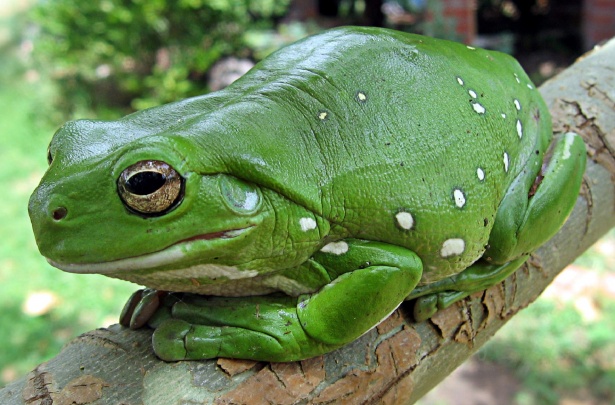ANIMAL: Magnificent/Splendid Tree Frog Ranoidea splendida Type of Animal: Frog Habitat: Forests, woodlands, caves, crevices, buildings, toilets, showers, water tanks, gorges, rocks, rockpools, rockholes, dunnies Location(s): NW coast of Australia Appearance: Olive to bright green dorsal surface w/ white ventral surfaces, undersides of feet/legs bright yellow, many adults have white or sulphur dots, large parotid glands (external skin glands) covering entire top of heads & drooping over tympana (external hearing structure) Food/Diet: Insects, worms, spiders, baby mice Status in Wild: Stable Conservation: Breeding in zoos, aquariums, & herpetoculture Lifestyle: Small groups of 2-5 frogs Additional Info: Called: Male Female Young: Tadpole Group: Army Weight: Male: 2 oz Female: 3 oz Gestation: 1 day Life Span: 8 years Body Length: Male: 4.1 in Female: 4.2 in Only predators are invasive cane toads. Nothing else often eats them due to foul tasting poison in parotid gland. These animals active at night (nocturnal). Male has loud “crawk-crawk-crawk” buzz call made in breeding season (wet/monsoon season). Females lay average of 1,000 eggs, forming floating mats in water. Tadpoles take 1-4 months to develop into adults. Bright coloration serves as warning that it’s not to be eaten. Like most tree frogs, they’re excellent climbers. Adhesive-like discs on toes come in handy for this purpose. Males release pheromone called Spendipherin into water to attract females. Besides preying on tree frogs, cane toads compete w/ them for food/space. Fun Fact(s): Sometimes kept as pets. 1st described only as recently as 1977. Has largest poison gland of all native Australian amphibians. While poison deters potential predators, it’s harmless to humans. Still not a good idea to put your mouth on a frog just for sanitary purposes.
